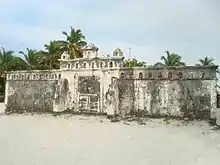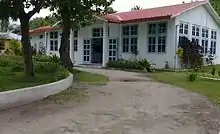Kendhoo
Kendhoo (Dhivehi: ކެންދޫ) is one of the inhabited islands of Baa Atoll, Maldives. It is located in the northern part of the Baa Atoll.
Kendhoo | |
|---|---|
 | |
 Kendhoo Location in Maldives | |
| Coordinates: 05°16′34″N 73°00′40″E | |
| Country | Maldives |
| Geographic atoll | Maalhosmadulu dekunuburi |
| Administrative atoll | Baa Atoll |
| Distance to Malé | 133.67 km (83.06 mi) |
| Area | |
| • Total | 0.145 km2 (0.056 sq mi) |
| Dimensions | |
| • Length | 0.600 km (0.373 mi) |
| • Width | 0.350 km (0.217 mi) |
| Population (2018)[1] | |
| • Total | 1,300 |
| • Density | 9,000/km2 (23,000/sq mi) |
| Time zone | UTC+05:00 (MST) |
History

Kendhoo is famous for its historical and cultural significance. It is said that the island was visited by the Arabian scholar, Abdul Barakaath Yoosuf al Barbary, also known as Thabreyzgefaanu, who is believed to have been responsible for introducing Islam to the Maldives in 1153.[2][3] While he stayed on the island, he taught Islamic rituals to the islanders and offered daily prayers there. The place where he stood to offer the prayers was marked by building the house named after him.
This building is still there, but some parts of this place were reconstructed by the Thalabath-noor Quran class in 2017. They cleaned the place and gave the facility of praying like the past days, in the past days some others also have repaired some damages at that place. They all did their best not to change the actual design of the place.
Demography
It is the most populated island among Kendhoo constituency.
| Year | Pop. | ±% |
|---|---|---|
| 2006 | 858 | — |
| 2014 | 1,023 | +19.2% |
| 2021 | 1,350 | +32.0% |
| 2006-2014: Census populations Source: [5] | ||
Economy
Traditionally, fishery, and thatch-making are the main occupations and major livelihoods of the people of Kendhoo. A significant number of the island’s youth work in resorts. In addition to this, there are people who do construction work and retail business.
Services
Kendhoo has electricity for 24 hours generated from a powerhouse with three generators. Recently an expansion project of the electricity service in the island was completed by installing a new generator set and replacing the panel board and the entire cable network installed in the island. The project was funded with RF1 million loan assistance from the Asian Development Bank.
The main issue facing the island is lack of a sewerage system. The residents of the island have raised this issue to the concerned authorities on several occasions. But as of today their concern has not been seriously addressed by the government.
Education

The island has a higher secondary school which teaches up to grade 10. In the school most of the teachers are local teachers. In addition, the island has a pre-school which is run by an NGO, Kendhoo Zuvaanunge Gulhun.
Healthcare

There is a Health Centre on the island which opens for sixteen hours a day. Currently the centre has an expatriate doctor for general consultations. The Health centre has also laboratory that investigate the diseases. The island has also 2 pharmacy run by STO (State Trading Organaization) and a private party. In addition Kendhoo is very famous for traditional herbal medicine, people from different parts of the country and even from other countries visit for treatments.
Transport
Harbour
The island has a harbour of 165 m (541 ft) by 55 m (180 ft) was reconstructed by the government in 2017. The project includes a 145-meter breakwater, a 42-meter sand-cement bag quay wall, dredging works for the existing and new harbour areas for 3 m (9.8 ft) from mean sea level, a 72 m (236 ft) rock boulder revetment and an 87 m (285 ft) sand/cement bag revetment. It also includes 181-metre-long (594 ft), 5-metre-wide (16 ft) pavement next to the quay wall and a 262-metre-long (860 ft) concrete block quay wall. The project also installed navigation lights and harbour lights for the new harbour. The project costs totalled MVR 29,294,992.10 of the government budget.
References
- "Table PP5: Resident Population by sex, nationality and locality (administrative islands), 2014" (PDF). Population and Households Census 2014. National Bureau of Statistics. p. 34. Retrieved 12 August 2018.
- "When Moroccan merchant Abu al-Barakat Yusuf al-Barbari converted the Maldives to Islam". yabiladi.com. 20 June 2018. Retrieved 29 July 2018.
- Kersey, Morris (2001). Victoria: Where Dreams Come True. Self published (Trafford - on demand). p. 126. Retrieved 29 July 2018.
- "Coordinate Distance Calculator". Boulter.com. Retrieved 12 August 2018.
- "Table 3.3: Total Maldivian Population by Islands" (PDF). National Bureau of Statistics. Retrieved 12 August 2018.